Are you wondering about the background image on The Mosaic banner? It was inspired by a page in one of our favorite artists’ books, Venus:

Booklyn Artists Alliance, the collective group of artists that created this book, describes Venus as a, “one-of-a-kind artist’s book made from Korean mulberry and cellulose paper, acrylic paints, pencil, walnut ink, Japanese black ink, human blood, turmeric and cayenne pigment suspended in Polyvinyl Acrylic, graphite dust painting, and other media. Techniques include body printing, aspiration, xlene graphite transfer, and multiple layering of media. The bark on the covers comes from a Prunus virginianum (chokecherry) that Kurt cut down for firewood in upstate New York.

The original pages for this book appeared as wall paintings in Organik’s ‘Spice Cave’ at Gallery Andante in Seoul Korea in 2008. Thick layers of impasto turmeric and cayenne pigment suspended in Polyvinyl Acrylic were layered onto the sheets. A few months later the large sheets were returned to Organik’s studio in Brooklyn and they were torn down into page size sheets. Then over the course of a year, after much research on the geography of the planet Venus, (primarily through recent NASA satellite photography) and much consideration over an epic love poem to the planet written by Weber, the collaborators painted collectively on the sheets in weekly and bi-weekly studio meetings.” With all of the spices incorporated into the production of Venus, it’s definitely a book that appeals to all the senses.

Our large and varied collection of artists’ books are often showcased in exhibitions and online displays. More importantly, they play a prominent role in the classes we teach. Artists’ books challenge and reinterpret the ‘book’ and our engagement with that familiar form. Students, faculty, and visitors to Special Collections all respond to artists’ books in ways that reinforce the value of the book as an artifact and an enduring vehicle for words and images. We’re always fascinated to hear how people “read” books beyond the information conveyed within the covers (and sometimes there are no covers in an artists’ book!). Visit us to see what we’re talking about, and become inspired to create, interpret, or simply read one of these treasures on your own!

